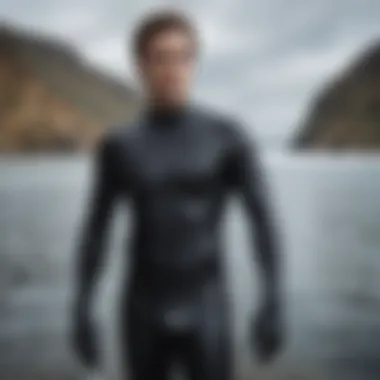Choosing the Best Wetsuit for Cold Water Sports


Intro
Finding the right wetsuit for chilly waters can feel like searching for a needle in a haystack. With a variety of brands and options out there, navigating through choices can get a bit overwhelming. Whether you're into kiteboarding, surfing, or any water sport, the right wetsuit can mean the difference between an enjoyable day on the water and an uncomfortable experience.
Cold water conditions pose unique challenges. The key is understanding how wetsuits work, their insulation, how they fit, and what additional features might benefit you. This article unpacks these components, guiding you through the crucial aspects of choosing a wetsuit tailored specifically for colder temperatures.
We know the struggle of keeping warm while engaging in the sport you love. The right wetsuit not only keeps you warm but also enhances your performance. So, let’s dive into some gear insights and tips to make an informed choice.
Understanding Wetsuits and Their Function
When it comes to engaging in water sports, especially in cold conditions, having the appropriate gear is not just a luxury, it’s a necessity. Wetsuits play a vital role in maintaining warmth and comfort, keeping the cold at bay while you enjoy your time on the water. The function of a wetsuit goes beyond simply being a barrier between the body and the cold water; it’s about maximizing your performance and enhancing your overall experience.
How Wetsuits Work
Wetsuits are designed to offer insulating properties while allowing for agility in the water. The key to their function lies in the materials used, predominantly neoprene, which traps a thin layer of water between the suit and the skin. As you enter the chilly water, this layer warms up and creates a thermal barrier that helps maintain your body temperature. Basically, the suit hugs your body closely, reducing water circulation within, and not allowing much cold water to enter for extended periods.
In practice, the thickness of the wetsuit often correlates with water temperatures. For instance, a 5mm thick suit might be suitable for waters that approach the lower end of the temperature scale, while thinner suits, around 2-3mm, suffice for slightly warmer conditions. Additionally, the design elements—like zippers and seams—play a big role in ensuring that the suit remains watertight.
Remember, a well-fitted wetsuit will not only offer better insulation but also improve your mobility, which is essential for activities such as kiteboarding where swift maneuvers can make or break your day.
Differentiating Between Wetsuits and Drysuits
While 'wetsuit' often gets tossed around as a catch-all term, understanding the distinctions between wetsuits and drysuits is crucial for making an informed choice.
Wetsuits, as previously mentioned, allow some water in, warming it up as you wear the suit. In contrast, a drysuit is designed to keep water completely out. They are usually worn in extremely cold conditions and often have cuffs to ensure that no water can seep in through openings.
It's also important to know that drysuits generally come with an inherent bulkiness, making them less ideal for active water sports compared to wetsuits that allow for more flexibility and range of motion.
In summary, if your adventure takes you into frigid waters but requires a degree of activity, a wetsuit is usually your best bet. However, for extended periods in really chilly conditions with minimal movement, a drysuit could be the better option.
"Selecting a wetsuit or drysuit isn’t just about personal preference; it’s about understanding the conditions you’ll be facing."
In essence, this understanding of wetsuits enhances the experience on cold waters, ensuring you can enjoy your time and focus on the thrill of the sport.
Why Cold Water Matters in Wetsuit Selection
Understanding the implications of cold water conditions is pivotal for anyone venturing into activities like kiteboarding or scuba diving. Cold water can have a drastic impact on both comfort and safety. When the temperature dips, the body loses heat more rapidly, which can lead to hypothermia if one isn’t adequately protected.
Effects of Cold Water on the Body
Cold water envelops the body, working against your innate thermal regulation. The chill can be shockingly immediate. As the temperature drops, vital functions become compromised. The body tries to conserve heat by diverting blood from the extremities to core organs. This could lead to numbness, decreased dexterity, and impaired muscle function—essentially, you’re running on borrowed time.
Consider this: when you're out there, every minute counts. Maintaining even a modicum of body heat is crucial. For example, studies show that water that's 50 degrees Fahrenheit can sap heat 20 times faster than air of the same temperature. This means that immersing yourself in cold water without proper gear is akin to stepping into a refrigerator—one wouldn’t do that without a good coat, would they?
Importance of Insulation and Thermal Protection
This highlights the need for insulation in wetsuits. The primary function of a wetsuit is to trap a layer of water between the suit and the skin. This layer, although cold, gradually warms up due to body heat. The effectiveness of this thermal protection can be broken down into several key aspects:
- Material Thickness: Wetsuits come in various thicknesses measured typically in millimeters. Thicker suits provide better insulation but can impede flexibility. A common thickness for cold water is around 4/3 mm.
- Insulation Technology: Wetsuits are now being made with advanced materials that not only block the cold but also wick moisture away from the body. Brands are increasingly utilizing technologies that are designed to keep you warmer in frigid waters by reflecting body heat.
- Seal Configurations: The design of the seals at the wrists and neck plays a huge role in minimizing water entry, thereby maintaining warmth. Flatlock seams, while comfortable, often let in more cold water than sealed seams or taped seams.
In colder conditions, wetsuits that offer optimal insulation can make the difference between an enjoyable experience and a fight for survival in the water. Investing in a proper wetsuit becomes not just a matter of comfort but a critical safety measure. Therefore, it’s imperative to take the time to explore the different features that enhance thermal protection to ensure a successful outing.
"Choosing the right wetsuit is like picking the right coat for winter; it can make or break your time outdoors."
Through understanding cold water’s effects and the importance of insulation, you're better equipped to make informed decisions about which wetsuit will best suit your needs for cold-water adventures.
Key Features to Look for in Cold Water Wetsuits
When selecting a wetsuit for those chilly waters, several key features can significantly influence your comfort and performance. Understanding these elements helps choose a suit that not only fits well but also enhances your experience in diverse aquatic conditions. The right characteristics can make the difference between tolerable sessions and enjoyable ones, especially when engaging in sports like kiteboarding or surfing in cold climates.


Thickness and Insulation Ratings
The thickness of a wetsuit generally varies from 2mm to 7mm, with thicker suits providing more insulation. When the temperature drops, the choice of thickness becomes crucial. A 4mm wetsuit will keep you warmer than a 3mm, but it also means increased buoyancy. As a rule of thumb:
- 3/2mm: Ideal for spring and fall conditions, where water is getting cooler but not frigid.
- 4/3mm: Great for colder waters, suitable for winter, especially for short sessions.
- 5/4mm and above: Best for harsh winter conditions, where prolonged exposure to icy waters is expected.
It's not just thickness that counts; the insulation rating provides insights into how well a suit will maintain warmth. Look for suits with high thermal ratings to ensure that you stay cozy without excessive bulk, which could hinder movement.
Material Composition
Material certainly matters when it comes to cold water wetsuits. Two main categories dominate: neoprene and eco-friendly alternatives. The choice depends on personal values and performance needs.
Neoprene Variations
Neoprene has become the standard for wetsuits due to its unique properties. Its primary characteristic is its insulating air bubbles: the more bubbles, the better the insulation. Variations like Limestone Neoprene provide added warmth while being lighter and more flexible compared to traditional petroleum-based neoprene. The benefit of this type is that it conforms to body shape easily, enhancing comfort and reducing water entry.
However, there’s a downside. Dense neoprene can feel restrictive if not fitted correctly, and some people find it too warm in less frigid conditions. Therefore, it’s wise to consider the water temperature you'll frequent and your personal tolerance to cold when choosing neoprene variations.
Eco-Friendly Alternatives
The rise in popularity of eco-friendly alternatives reflects a growing awareness of environmental issues. These materials, such as Yulex, sourced from rubber trees, offer competitive insulation and flexibility without the harmful impacts associated with traditional neoprene production. A standout feature is that many eco-friendly suits are also designed to maintain performance in various temperatures, ensuring you remain protected without compromising your principles.
However, their market presence is still somewhat limited, and they might come at a higher cost. Some users may find them not as durable as conventional neoprene, but advances in technology are continuously bridging that gap. Ultimately, selecting eco-friendly materials contributes not only to personal comfort but also to a more sustainable future in watersports.
Seam Construction and Waterproofing
Seam construction is an often overlooked aspect of wetsuit selection. The way seams are stitched or bonded affects how well the suit retains warmth and keeps water out.
- Flatlock seams: Often found in warmer water suits, these are not as effective in preventing water entry.
- Glued and blind-stitched seams: A common choice for cold water suits, these seams provide better insulation and waterproofing.
- Taped seams: Techniques here can enhance overall durability while preventing leaks, ideal for harsher conditions.
Opt for suits with robust seam construction that offer a balance of flexibility and insulation. It’s about finding what keeps you dry while ensuring mobility. Choosing a wetsuit with the right seam design significantly enhances the overall performance during your cold water adventures.
In summary, the right wetsuit material, thickness, and seam construction can dramatically affect your cold water experience, providing warmth, comfort, and ensuring you stay in the action longer, regardless of the temperature.
Factors Influencing the Perfect Fit
When it comes to selecting a wetsuit for cold water, how well the garment fits can significantly impact not just your comfort but also your overall performance. A good fit can keep warmth trapped while allowing for the freedom of movement necessary in water sports like kiteboarding. A snug yet flexible wetsuit helps maintain body heat, reducing the chances of overheating or losing warmth, both of which can affect your time on the water. Understanding what influences the perfect fit is key to making the right choice.
Understanding Sizes and Measurements
Getting your measurements right is the first step in ensuring a proper wetsuit fit. Each wetsuit brand often has its own sizing chart, and these can differ quite a bit. Here are several elements to consider:
- Body Measurements: You'll typically need to measure your chest, waist, hips, and inseam. Flexibility in these areas should not be neglected. Even slight discrepancies can lead to discomfort.
- Weight Considerations: It’s important to find a suit that works well with your body weight. Heavier individuals may require a different cut or thickness.
- Style Fit: Wetsuits come in various styles, such as short-sleeve, long-sleeve, or full-body. Choose a style that complements your activities; for instance, a short-sleeved wetsuit could be useful if you frequently engage in underwater activities where arm movement is crucial.
Taking accurate measurements and comparing them with the size charts provided by various brands can help you find that ideal fit. A misfit not only hampers performance but can increase the risk of hypothermia in chilling waters.
Tailored vs. Off-the-Shelf Options
When you venture into the market for a wetsuit, there’s typically a choice between tailored options and off-the-shelf models. Each has its advantages and is worth discussing in detail.
Tailored Wetsuits
Custom-fit wetsuits are built specifically for the individual. Here are some upsides:
- Precision Fit: Tailored wetsuits address all specific body contours, ensuring warmth and comfort, particularly in key areas like joints and neck.
- Personalization: You can choose the design, color, and thickness to match your personal wariness of the cold.
However, the disadvantages often include higher costs and longer wait times for production.
Off-the-Shelf Wetsuits
These are widely available and come in a range of sizes. The benefits include:


- Immediate Availability: You can try various sizes and pick one off the rack without a waiting period.
- Cost-Effectiveness: Off-the-shelf models are generally less expensive than custom wetsuits, making them a more appealing option for those just starting out or those who aren't yet sure their watersport obsession is long-term.
Yet, fitting can be a hit or miss, as the universal sizes may not match every person's unique shape. Ultimately, the choice between tailored and off-the-shelf boils down to personal preference, budget, and how much time you want to invest in finding that right fit.
Bottom Line: A properly fitting wetsuit can make all the difference—keeping you warmer, more comfortable, and allowing you to maximize your performance on the chilly waves.
Features Enhancing Performance in Cold Water
Choosing a wetsuit for cold water is not simply about staying warm; it’s essentially a balancing act between comfort and performance. These features that enhance a wetsuit’s performance can dramatically affect not just how long you can stay in the water, but also how effectively you can perform your sport, like kiteboarding.
Hooded Wetsuits
Hooded wetsuits are often overlooked, but they can make a substantial difference when you're in icy waters. The head is a major area where heat escapes, and covering it can keep your core temperature much more stable. When you’re out kiteboarding or surfing in frigid conditions, a hooded wetsuit ensures that you don’t lose warmth through your head while also protecting your ears from the cold.
- Why a Hood Matters: Not only does a hood prevent heat loss, it also shields your head from wind and splashes that can sap your energy. Cold water can be a real bummer, knocking the enthusiasm right out of the waves, but a snug hood allows you to focus on your fun without constantly battling the chill.
- Considerations: When choosing a hooded wetsuit, opt for one that offers a snug yet comfortable fit. If it’s too loose, the flushing of cold water can nullify its benefits. Look for hoods that have sealed seams and are made of high-quality neoprene to keep water from trickling in.
Integrated Booties and Gloves
When it comes to cold water, your extremities often feel the brunt of the cold the most. Integrated booties and gloves are key components that can enhance your overall experience and performance. These features help ensure that your hands and feet remain warm, promoting good circulation and overall comfort.
- Booties: Look for wetsuits that offer integrated booties for that added warmth and protection. Booties help in providing traction on your board, reducing the likelihood of slipping during maneuvers. Also, they offer insulation from the icy touch of the surf.
- Gloves: Integrated gloves keep your fingers warm while still allowing for dexterity, so you can comfortably control your kite or board. Be sure to choose gloves with a good grippy surface to ensure that you maintain control in slippery conditions.
Fact: Using integrated booties and gloves in combination can reduce the frustration that comes from cold fingers and toes, extending your water time.
How to Maintain Your Cold Water Wetsuit
Taking proper care of your cold water wetsuit is not just a matter of preserving its aesthetic appeal; it significantly impacts its functionality and longevity. By developing a consistent maintenance routine, you ensure that your wetsuit remains an effective gear for your water adventures, saving you in replacement costs and enhancing your comfort as you face chilly waters. Remember, every time you hit the waves or any cold-water activity, your wetsuit goes through a lot of stress and exposure to elements. Hence, treating it with respect will reward you with years of reliable performance.
Cleaning and Storage Practices
Cleaning your wetsuit may sound tedious, but think of it as an essential step to keeping it in tip-top shape. After every session, it's important to rinse it with fresh water. Salt, sand, and grime can build up and degrade the neoprene over time. This simple act of rinsing can prevent unnecessary wear and tear.
Initial steps to proper cleaning include:
- Rinsing: Always rinse your wetsuit in cool, fresh water. Avoid using hot water, which can damage the neoprene.
- Mild detergent: When the suit appears especially dirty, a gentle wetsuit-specific detergent can be useful. Strong laundry detergents should be avoided.
- Inverted drying: Hang your wetsuit inside out to dry, away from direct sunlight. Sunlight can warp and degrade the material, leading to cracks.
- Storage: Once dry, store your wetsuit flat or on a wide hanger, not folded. Storing it rolled up can lead to creases that are hard to remove and may weaken the material.
A good general tip is, "if you take care of your gear, it will take care of you." Also, remember to check its condition before your next water outing. Regular maintenance means you can catch issues before they escalate—attending to minor damages early can prevent a complete disaster down the line.
Repairing Minor Damages
Even the sturdiest suits are prone to the occasional scrape or puncture, especially in rocky environments or heavy usage scenarios. Knowing how to handle minor damages can extend the life of your wetsuit significantly. Here are the signs to look out for:
- Pinholes: These tiny holes, often created by wearing your suit during rough activities, can allow water to seep in and chill you.
- Cracking or peeling: Inspect the seams and areas like the knees and elbows, where wear is common.
For quick repairs, you may opt for:
- Neoprene glue: A simple tube of neoprene cement is great for sealing small punctures. Clean the area first, apply glue, and let it cure completely before using the wetsuit again.
- Patch kits: Available at most sporting goods store, these kits include everything you may need to carry out a quick patch job. They can work wonders on larger tears or worn areas.
"A stitch in time saves nine." Taking a moment to address those little rips can save you the hassle of a larger repair or replacement later.
Final Thoughts
Comparative Analysis of Popular Cold Water Wetsuits
In the realm of cold water sports, choosing the right wetsuit can make all the difference between a delightful experience and a bitterly uncomfortable one. A comparative analysis of popular cold water wetsuits is vital because it equips adventurers with the knowledge to make savvy decisions. With several brands and styles available, understanding the nuances can pay off not just in warmth, but also in performance and durability.
A good wetsuit can be your best friend; it keeps the cold at bay and allows you to enjoy the ride.


When examining wetsuits, several factors come into play. Each brand brings its own strengths, materials, and design philosophies to the table. This diversity helps cater to different preferences, from thickness to specific features like hoods or built-in insulation. Knowing these differences not only aids in choosing a suit suitable for specific cold water conditions but also enhances overall performance in the water.
Brands Known for Cold Water Expertise
A few names stand out when it comes to cold water wetsuits, particularly those that kiteboarders trust and recommend. Brands such as O'Neill, Rip Curl, and Xcel have carved their niche in this segment due to their commitment to quality and functionality.
- O'Neill offers options that are renowned for their plush insulation and comfortable fit, making them a favorite among those who commonly find themselves in chilly waters. Their technology focuses on lightweight warmth, a vital concept for those who engage in long sessions.
- Rip Curl is celebrated for its innovation and has several models with varying thicknesses. They often incorporate advanced materials designed for maximum flexibility, which is crucial for maintaining performance while riding.
- Xcel, on the other hand, takes a slightly different approach, focusing on durability alongside comfort. Many users appreciate their suits for the extra attention given to seam sealing and waterproofing, which extends the life of the wetsuit.
Price Point vs. Performance
When it comes to wetsuits, the age-old question often arises: How much should one spend? There’s a delicate balance between price and performance that requires consideration. Higher-priced suits often reflect advanced technology and better materials; however, several budget-friendly options offer good performance without breaking the bank.
When assessing price points, consider the following:
- Invest in Comfort: More expensive wetsuits usually feature higher-quality neoprene, which translates into better stretch and warmth. Comfort matters, especially when you’re battling the elements.
- Frequency of Use: For those who regularly engage in cold water activities, investing in a pricier model may yield better long-term value, as durability adds to the overall cost-effectiveness of the wetsuit.
- Seasonal Consideration: Sometimes, the cost of a wetsuit can depend on how often you’ll use it during the season.
Ultimately, selecting the right wetsuit involves some soul searching. Balance your budget against your need for warmth, flexibility, and reliability. It’s always beneficial to read reviews and compare testimonials from fellow kiteboarders, as real experiences can offer insights that specifications alone cannot.
User Experiences and Feedback
When it comes to selecting a wetsuit for cold water, the voices of those who have been through the ringer are invaluable. User experiences and their feedback form a cornerstone of knowledge that can help future wearers dodge a few bullets. Reading about the struggles and triumphs of fellow adventurers provides insights that a brand��’s marketing spiel simply can’t deliver. In this section, we delve into two crucial aspects: testimonials from die-hard cold water enthusiasts and the common hiccups they’ve faced along with their pragmatic solutions.
Testimonials from Cold Water Enthusiasts
Hearing real stories can cut through the noise and lead you to make informed choices. Testimonials reveal how certain wetsuits perform under pressure, both literally and figuratively. For instance, one kiteboarder shared, "I’ve tried it all from insert brand name here to what seems like a dozen others, but nothing keeps me warm like the insert another specific brand here. The fit hugs every curve without feeling constricting, and I’ve tackled waves as low as 10 degrees Celsius with full ease.
These endorsements often highlight essential features; things like mobility, warmth retention, and the overall feel during cold-water activity. They might mention how a particular wetsuit’s thermal lining prevented that dreaded chill on early morning sessions. Another user noted, "There’s nothing worse than freezing hands; I thought I was tough until I tried gloves that actually kept me warm. My performance skyrocketed with the right gear.
Through these testimonials, fellow enthusiasts learn about experiences it’s like failed and successful attempts with various products, which helps narrow down their choices. These insights can guide users towards brands and designs that are truly effective in cold water conditions.
Common Issues Faced and Solutions
No wetsuit is perfect, and as any seasoned cold water explorer will tell you, understanding the potential pitfalls can save a world of inconvenience. Common issues range from sizing problems to wear and tear due to rough conditions. Here are some frequent problems encountered in the field:
- Leaking seams: A tight seal on your suit is crucial. Users often discover that seams don’t hold up well over time, leading to water seepage. The solution? Regularly check your seams and invest in suits with reinforced stitching. Certain brands are known for heavy-duty seams that withstand the test.
- Soreness or chafing: Many have reported discomfort after long sessions. This can usually be mitigated with a well-fitting wetsuit. For instance, some folks have found that a slightly looser fit prevents rubbing without compromising insulation.
- Difficulty putting on or taking off: A snug fit is key but can sometimes lead to cumbersome dressing experiences. Silicone or internal linings can help here; they allow for easier movement in and out of the suit.
- Temperature management: Adjusting to unpredictable cold whiskers is a common complaint. Users have learned to layer their gear strategically; incorporating merino wool base layers, for instance, can do wonders.
Feedback from real users not only illuminates these problems but also unearths a realm of solutions. They often suggest tailored adjustments or recommend specific aftermarket products that complement their suits, creating a feedback loop of improvement that's beneficial for the entire community.
While manufacturer specifications are significant, user experiences offer a nuanced perspective that bridges the gap between expectation and reality. By taking the time to sift through these testimonials and common issues, future buyers can arrive at decisions that will enhance their cold water adventures, rather than hinder them.
Future Trends in Wetsuit Technology
The landscape of wetsuit technology is constantly evolving, and understanding these trends can prove invaluable for those who regularly engage in cold water activities. Emerging innovations not only enhance performance but also address environmental concerns, making them pertinent to today's conscious consumers. With shifting consumer preferences and technological advancements, staying informed about what’s on the horizon is essential for making wise decisions. This section will explore recent developments that could alter the way enthusiasts choose and use their wetsuits, placing focus on two central themes: material advancements and sustainability in production.
Innovations in Material and Design
The materials used in wetsuits are seeing some exciting transformations. Traditionally, neoprene has dominated this segment, but newer formulations come into play that offer benefits like increased flexibility, lighter weight, and better thermal protection. For instance, some brands are incorporating limestone-based neoprene, which is not only supportive of performance but also less impactful on the environment compared to conventional petroleum-based versions.
Furthermore, advancements in texture and design can significantly benefit users. Special coatings and patterns are being developed to reduce drag in the water, enhancing the overall speed for kiteboarders and other water sports enthusiasts. These innovations often focus on achieving a snug fit while maintaining warmth.
Another trend is the introduction of smart wetsuits integrated with monitoring technology. Imagine a wetsuit that tracks your body temperature and provides real-time feedback, helping you avoid potential hypothermia when the water gets too cold. Such innovations bridge the gap between technology and practicality, enabling a safer experience for users. While we might still be a tad away from mainstream adoption, the potential is undeniably intriguing.
Sustainability Efforts in Wetsuit Production
As the world becomes increasingly aware of environmental degradation, wetsuit manufacturers are stepping up to the plate. Sustainable production methods are gaining prominence, with some companies now using recycled materials in the creation of their products. This not only minimizes waste but also redefines the concept of performance without compromising environmental integrity.
Efforts like using scraps from previous wetsuit manufacturing processes or sourcing eco-friendly materials make a significant impact. Such materials tend to have lower toxic emissions during production, checking one box on the way to a more sustainable future.
Additionally, brands are beginning to adopt more responsible practices throughout their supply chains — from ethical sourcing of raw materials to fair labor practices in manufacturing. Shoppers can feel good about their purchases, knowing that their wetsuit is crafted with care and consideration.
Remember, as we are out there enjoying the cold waters, making a conscious choice also benefits the aquatic systems we cherish.
In summary, the latest trends in wetsuit technology emphasize not only performance but also a commitment to sustainability. With advancements in materials and a growing awareness of environmental impact, future wetsuits are designed to keep thrill-seekers warm while fostering a healthier planet. This thorough understanding allows consumers to make informed decisions, ensuring their gear is not just suitable for extreme conditions, but also aligns with their values.















